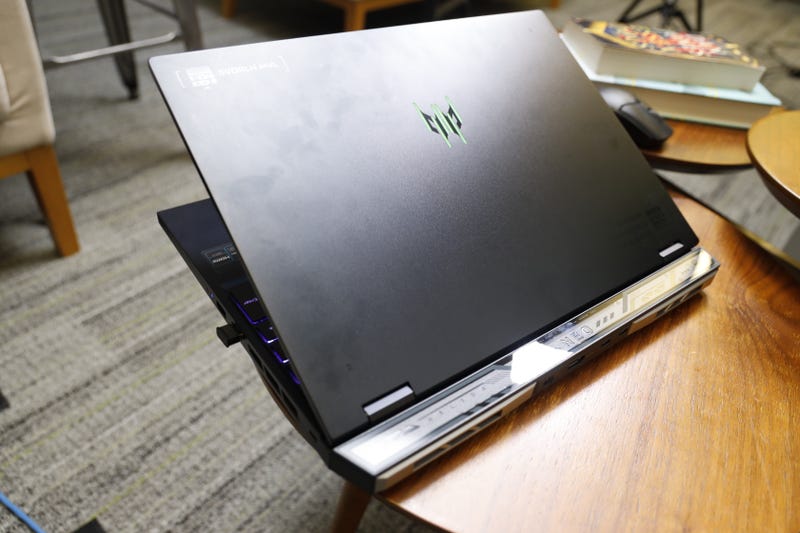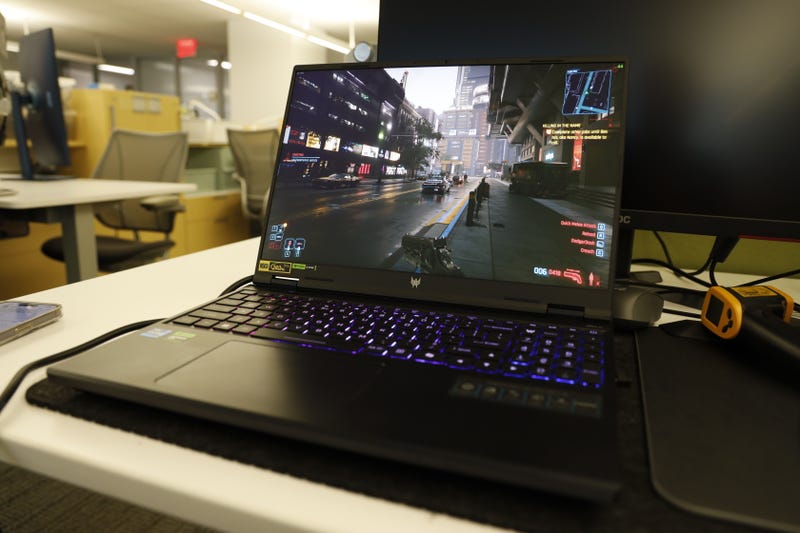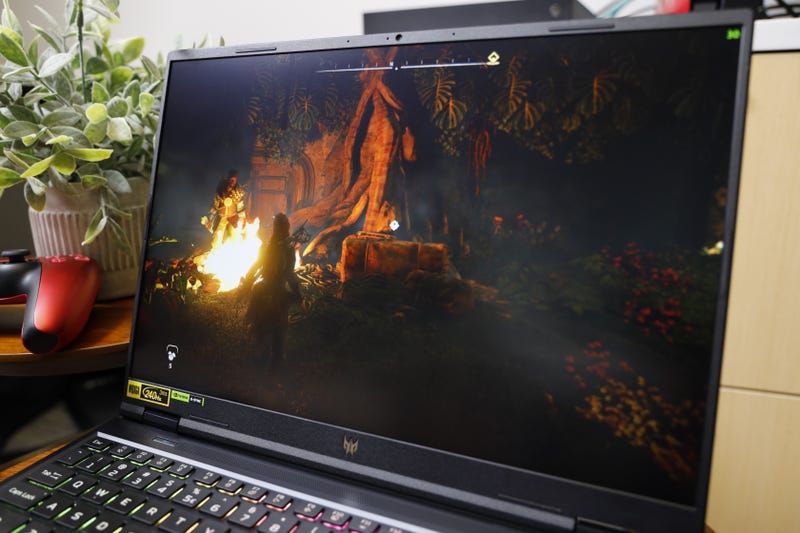Acer Predator Helios Neo 16 2024
The Predator Helios Neo 16 looks the part and does the job if all you want is to push framerates, but it’s at the cost of pure usability.
Pros
Cons
There’s a tightrope every gaming laptop needs to walk, and it is truly so difficult to balance everything before tipping over one edge or the other. You want something that most people can afford, with all the bells and whistles, and you want it to feel good and look good. But price and performance are an inverse relationship, and inevitably, something has to give to keep things cheap.
Acer’s Predator Helios Neo 16 manages to thread that needle pretty well, packing a lot of punch for its sub-$US2,000 price with the top specs. But once you get it running, the tradeoffs are glaring enough that they dramatically cut into the full enjoyment of what could be a quality budget-ish machine.
The Predator Helios Neo 16 starts at a low of $US1,200 and tops at close to $US1,700 for this year’s and last year’s models. That’s a wide gulf between all nine models; of the four with 14th-gen Intel CPUs, you will have to spend as much as $US1,450. Even with a new shell design, the latest version of the Helios Neo 16 with the top specs seems to be right at the edge of its limits.
With a Nvidia GeForce RTX 4070 and an Intel Core i7-14700HX, things tend to run hot quickly, even with “balanced” performance with the fans starting to go full throttle. And don’t even ask about battery life. Even on minimal settings, you’re lucky to get a few hours out of it before the laptop practically begs for a charge. There’s a lot to enjoy with the Helios Neo 16, but nothing that’s truly so stellar that I would say you should spend more than $US1,500.
Acer Predator Helios Neo 16 Build Quality and Heat
I’d Prefer a Laptop That Doesn’t Warm My Mouse Hand

This budget laptop may be better if you purchase it at lower specs rather than straining it with the most high-end parts you can get. Most of that concerns Acer’s heat system, which I found to be a constant annoyance. Either you deal with loud, oddly-placed fans or throttle performance.
I found that the side-facing vents blow out just as much hot air as the rear fans, which is unfortunate because that’s where I—along with most other human beings—tend to keep my mouse. I registered an external temperature of 145 degrees directly on the chassis next to the fan exhaust, which meant the desk next to the fan also tended to get pretty warm. It wasn’t enough to make gaming uncomfortable, but it’ll only be a boon for folks in cold enough latitudes that the extra heat might warm your frigid fingers.
The keyboard itself only rose to a high of 98 degrees Fahrenheit in the very center, and it never felt uncomfortable to lay my sensitive hands and fingers on the palm rest. That being said, the internals also tend to get hot. In my experience, the balanced mode on Acer’s PredatorSense software puts the fan speed too low, even for middling games. The CPU reached a high of 92 degrees Celsius, while the GPU reached a high of 91 degrees Celsius in some titles. When it got that high, the heat did impact performance. You can manually crank up the fans to sub-helicopter levels, enough to draw a concerned glance from my roommate passing by in the hallway.
In Performance mode, the fans go much harder. This results in far more managed internal temps at the expense of your once-cool desktop. There’s no perfect option, and it seems to point to the top-end specs being a little too much for the Helios Neo 16.
Otherwise, the build quality is just fine. As you might expect with the thermal shelf, it’s too big to fit inside a typical backpack laptop sleeve, but it still feels sturdy. It’s a thick, relatively heavy gaming laptop that’s not trying to boast the most power per square inch. Based on those metrics, it’s pretty adequate. I appreciate how the new redesign has enclosed the display while maintaining an HDMI port, two Thunderbolt 4 USB-C Ports, ethernet, and a micro-SD card slot. The memory and storage are upgradeable if you think you need more.
I previously called the $US3,220 Lenovo Legion Pro 7i 16 the “kitchen sink” laptop for how much stuff was jammed in, including the Numpad keyboard. The Predator Helios Neo 16 similarly sports the Numpad by adding a dedicated key to bring up the PredatorSense software. Despite being the same size, its design feels more cramped with the extended, pointless Copilot key and shrunken right shift. Other than that, the individual keys feel all right, though just a hair too soft for most gamers wanting nice feedback. The trackpad is a real bust, with terrible palm rejection and a dry feel that makes you immediately jump for the mouse whenever possible.
Acer Predator Helios Neo 16 Performance
Solid Performance With the Included Specs

The Predator Helios Neo 16, with the specs on my review unit, is outside what I would want to consider a “budget” gaming laptop. My configuration included an RTX 4070 laptop GPU, 32 GB of RAM, and an Intel Core i7-14700HX. You can get a wide variety of configurations on the Neo 16, and at a minimum, you would pay as low as $US1,200 for a laptop with an RTX 4050 and a Core i5-13500HX for last year’s model.
In Cyberpunk 2077, I could reach a base average of 60 FPS on benchmarks and in gameplay with high settings and ray tracing without DLSS enabled. You can easily get closer to a 70 or 80 FPS average in benchmarks and some in-game areas with DLSS without ticking off all the ray tracing options.
Baldur’s Gate III has received some pretty staggering performance updates lately. The Helios Neo 16 with an RTX 4070 in Performance mode could do 100 FPS in indoor environments and easily go above 80 FPS in the outdoor environments of Act I. In the city of Act III I, the average FPS is 65, dipping to the low 50s. With DLSS Performance mode, you can push it up to more than double that if you’re desperate to take advantage of the 240 Hz display on a turn-based game. Otherwise, you can get a few more frames out of Quality mode and take the time to enjoy the visuals instead.
In a game like Horizon: Forbidden West, I managed a solid 60 FPS on high settings, whether in outside environments or interiors. Suffice it to say that with these specs, you’ll hit solid frame rates on any game you’d think of trying. On Geekbench 6 and Cinebench CPU tests, I could hit just under that of the Legion Pro 7i 16 with its Intel Core i9-14900HX in single-core tests, though more in multi-core. That’s pretty damn good, considering the price difference between the two machines. The CPU will beat the Asus ROG Zephyrus G14’s AMD processor if you only care about top speeds. In 3D Mark tests like Time Spy, you’ll start to understand the difference between a more and less expensive laptop, even with the RTX 4070. That being said, it’s still solid.
And yet, there are enough heat issues that I would suggest not gunning for the most intense specs on this budget-friendly laptop. If I were shopping for one of the Helios Neo 16 models, I would first consider one of the sub-$US1,500 models with an RTX 4060, but don’t take these benchmarks to mean anything for cheaper models.
Acer Predator Helios Neo 16 Screen and Sound
An Okay Display Combined with Lackluster Audio

The Helios Neo 16 now sports up to a 240 Hz WQXGA display (2560×1600). It’s just your regular old IPS LCD with a stated 3ms response time, so if it weren’t for the high refresh rate and built-in Nvidia G-Sync, this screen would seem rather barebones.
You would want the 240 Hz refresh rates for those twitchy multiplayer shooters or MOBAs that need those speeds, and you would probably need to reduce your in-game graphic settings to find a matching framerate. For somebody buying a sub-$US2,000 gaming machine, I would suggest a better-looking screen to match the higher-fidelity graphics rather than find something that will push higher refresh rates.
We tested the display brightness and recorded 500 nits peak at full-screen, which is exactly what Acer promises out of the box. It’s bright enough for your daily use but won’t wow you.
Sound-wise, you could do worse, but not much worse. The Helios Neo 16 won’t be your first destination for quality audio. Even something as simple as a YouTube video sounds tinny and echo-y. The bass is absent, and you won’t feel like you’re getting nearly as good an auditory experience as you would performance.
Acer Predator Helios Neo 16 Battery Life
It Really Wants to Stay Plugged In

Even on Eco mode with automatic screen dimming and no RGB lights active, the Predator Helios Neo 16 seemed to drain the battery like a leaky boat. I cast off the power cable and just let it sit there, running with nothing really happening on screen, and within less than 30 minutes, I checked back to see it run down by 20%. After about two hours, I was in the red.
On Balanced settings, doing just some typical productivity and browsing. I didn’t get two hours of battery life before it needed a bit of juice. It was so quick I checked PredatorSense to ensure there weren’t any issues, but the monitoring software gave me the thumbs up.
This machine wants to keep you hooked up on your desktop forever. Like an old man past his prime, you should only consider taking it outside if you don’t expect it to run too long.
The Acer Predator Helios Neo Tries to Be Too Many Things
Acer’s budget-friendly design works in many different ways, and if all you want is a gaming laptop that won’t break the bank for the quality of its specs, it does work. However, there are tradeoffs; there are too many to justify it for much, but there are rather strict use cases. I wouldn’t think about buying a version that costs closer to $4,000, but you could consider one below $US1,500, where the tradeoffs make more sense. Even if the laptop looks like it’s packing enough power to justify itself, remember that this could be used beyond gaming. With bad sound, an okay screen, and lackluster usability, it just won’t make much sense for all but the laser-focused gamer.
Buy from Acer and Harvey Norman
